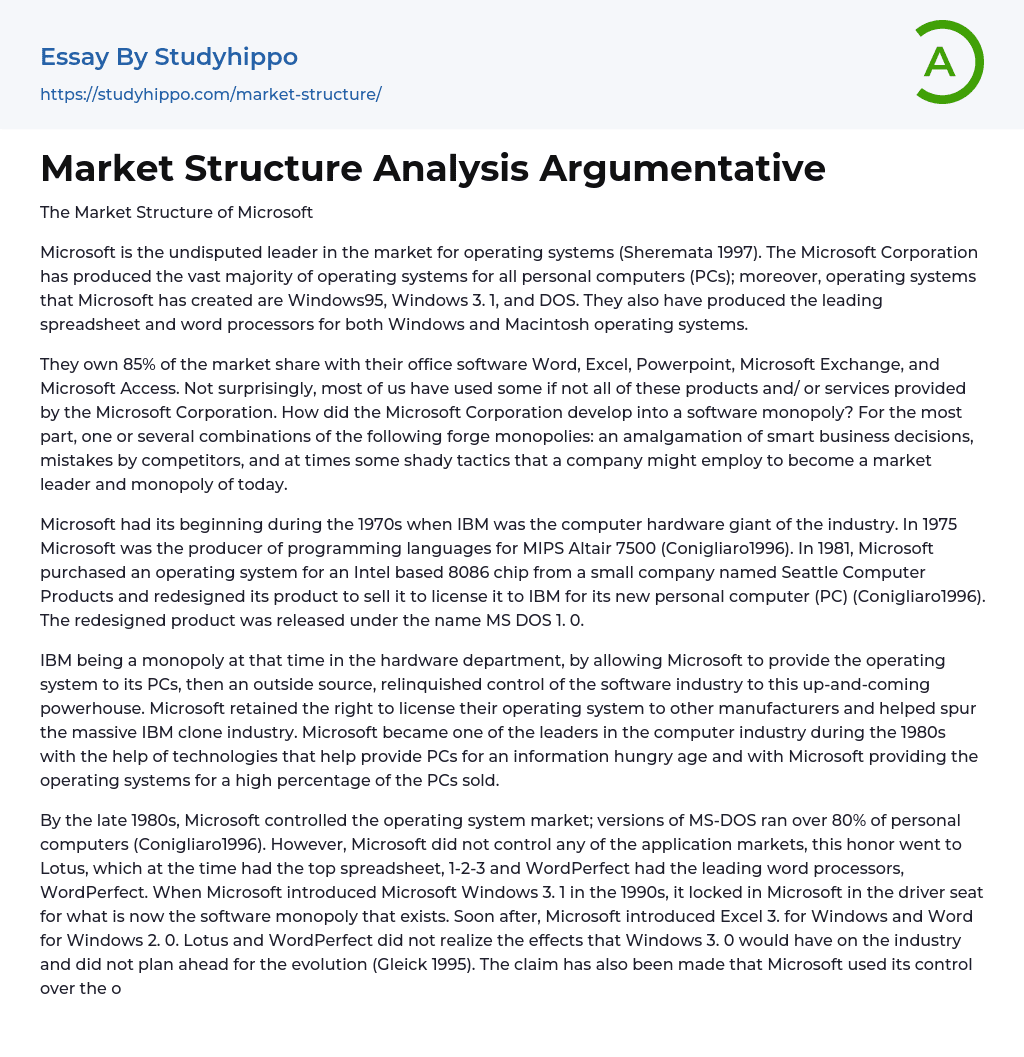The Market Structure of Microsoft
Microsoft dominates the market for operating systems, being the leading provider of operating systems for all PCs (Sheremata 1997). Microsoft has developed popular operating systems such as Windows95 and Windows 3.
Microsoft Corporation has become a software monopoly by developing leading spreadsheet and word processors for Windows and Macintosh operating systems. They currently own 85% of the market share with their office software Word, Excel, Powerpoint, Microsoft Exchange, and Microsoft Access. Many of us have used these products and/ or services provided by Microsoft. The company's path to monopoly status involved a combination of smart business decisions, competitors' mistakes, and sometimes questionable tactics.
During the 1970s, Microsoft emerged while IBM dominated the computer hardware industry. In 1975, Microsoft created programming languages for the M
...IPS Altair 7500 (Conigliaro1996). In 1981, Microsoft acquired an operating system from Seattle Computer Products for the Intel-based 8086 chip. They then redesigned and licensed it to IBM for their new PC (Conigliaro1996). The revamped product was released as MS DOS 1.0.
In the 1980s, IBM had a monopoly in hardware but allowed Microsoft to provide the operating system for their PCs. This decision relinquished control of the software industry to Microsoft, which was rapidly gaining power. Microsoft licensed their operating system to other manufacturers, leading to the rise of the IBM clone industry. With their technology and operating systems dominating the market, Microsoft became a major player in the computer industry by controlling over 80% of personal computers with MS-DOS running on them by the late 1980s. However, they lacked control over any application markets as leaders like Lotus and WordPerfect dominated spreadsheet and word processin
software respectively. The introduction of Microsoft Windows 3 marked a significant milestone in Microsoft's journey.
1 During the 1990s, Microsoft became the leading software monopoly by introducing Excel 3. for Windows and Word for Windows 2.0. Sadly, Lotus and WordPerfect were not aware of the significant impact that Windows 3. would have.
Gleick (1995) claimed that Microsoft did not foresee the impact of the Internet on the industry and failed to adequately plan for its evolution. There are allegations that Microsoft used its dominance in the operating system and graphical user interface markets to drive growth in applications. Some executives within the company even mentioned a "Chinese Wall" where certain developers received early access to the operating system, giving them an advantage over other companies (Gleick 1995). Additionally, Microsoft faced criticism for granting exclusive access to their new technology, OLE (object linking embedding), only to Excel 3 upon its introduction in Windows.
Initially, only Microsoft developers were able to integrate the technology into Excel, giving them a head start over their competitors in creating similar applications. This allowed Microsoft's applications to work with each other before other companies had the opportunity to offer comparable solutions. When Windows 3.1 was introduced, enhancing version 3, Microsoft further solidified their dominance in the application market. As a result, Microsoft's Excel, Word, and Office began to reign supreme, establishing their monopoly empire.
During the 1990s, Microsoft expanded its range of products beyond application and operating systems. In addition to multimedia and business operation systems, they also ventured into games and online services. One controversial move was their attempted acquisition of Intuit, a software company that owns Quicken, the popular personal finance manager. This
raised concerns about their business practices. Microsoft's bundling of Windows 95 with The Microsoft Network also posed a threat to competitors by creating barriers and inhibiting innovation and competition throughout the industry. By leveraging its dominant position in the operating systems market, Microsoft successfully grew into the powerful company it is today.
A combination of successful business strategies, poor decisions made by competitors, and the exercise of its newfound power by Microsoft have rendered the company unbeatable by rivals. Throughout our nation's history, we have witnessed various instances of monopolies, which have often hindered innovation. In the realm of computer systems, innovation is crucial for staying ahead in the market. IBM serves as a noteworthy example, as its business split paved the way for numerous new enterprises that ultimately benefited society. Consequently, if Microsoft is compelled to divide itself, it remains to be seen whether this action will bring about positive societal impact. The splitting of Microsoft would grant opportunities to aspiring entrepreneurs, potentially allowing them to introduce the next groundbreaking operating system.
- Microsoft Windows essays
- Android essays
- Application Software essays
- Benchmark essays
- Computer Network essays
- Computer Programming essays
- Computer Security essays
- Computer Software essays
- Cryptography essays
- Data collection essays
- Data Mining essays
- Graphic Design essays
- Information Systems essays
- Internet essays
- Network Security essays
- Website essays
- World Wide Web essays
- Adidas essays
- Amazon essays
- Apple essays
- Bmw essays
- British Airways essays
- Burger King essays
- Coca-Cola essays
- Company essays
- Costco essays
- Dell essays
- Ebay essays
- Enron essays
- Facebook essays
- Ford Motor Company essays
- Gap essays
- General Motors essays
- Google essays
- Honda essays
- Ibm essays
- Ikea essays
- Intel essays
- Iphone essays
- Johnson and Johnson essays
- Kellogg essays
- Key essays
- Kfc essays
- Mcdonald's essays
- Microsoft essays
- Myspace essays
- Nestle essays
- Netflix essays
- Nike essays
- Nokia essays




